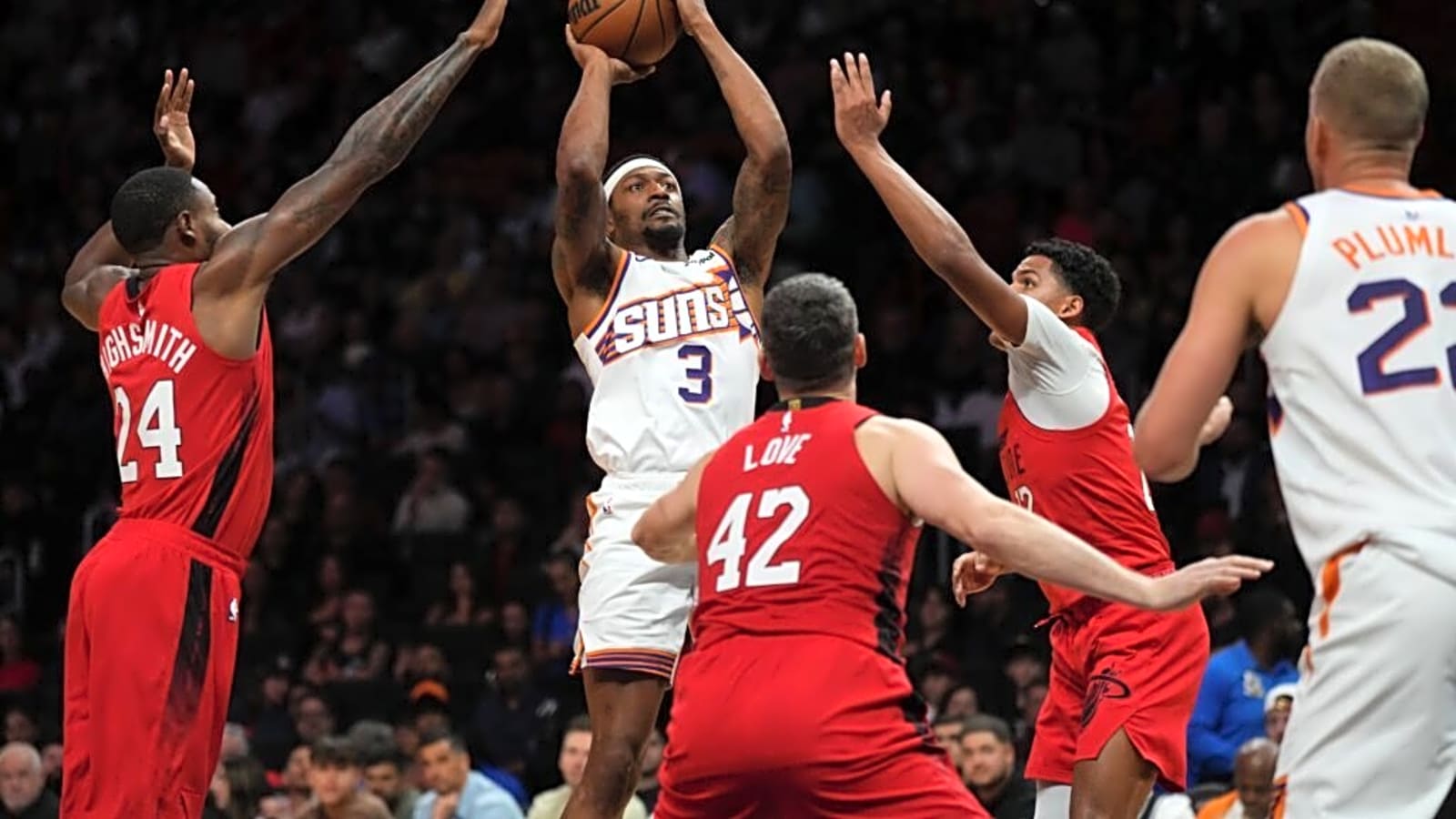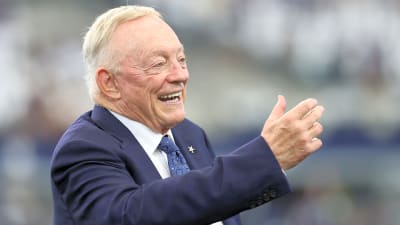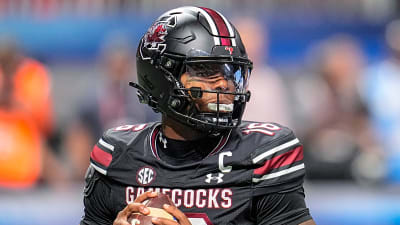
Apparently, the Miami Heat’s decision to trade defensive specialist Haywood Highsmith wasn’t just about reducing their payroll heading into the season. That’s what it seemed like on the surface after they shipped him and a 2032 second-round pick to the Brooklyn Nets in exchange for a 2026 second-round pick. However, on the heels of that deal, they offered a three-year contract to Dru Smith.
Why The Heat Picked Dru Smith Over Haywood Highsmith
With a total value of $7.9 million, Smith’s average annual value (AAV) of his contract will be $2.6 million, less than half of what Highsmith is making in 2025-26 ($5.6 million). Thus, from that standpoint, the Heat have still managed to trim down their expenses. In fact, Miami got underneath the luxury tax by trading Highsmith, per Third Apron cap expert Yossi Gozlan.
The Miami Heat are signing guard Dru Smith on new a three-year contract, sources tell ESPN. Smith has developed within the Heat program and has overcome season-ending ACL and Achilles tendon injuries in each of the past two years. pic.twitter.com/q4wjv89FrS
— Shams Charania (@ShamsCharania) August 16, 2025
They also created a $5.6 million trade exception that could prove to be useful down the line.
The Miami Heat get under the luxury tax by trading Haywood Highsmith.
They need to sign one more player but have enough space to stay under the tax with a minimum signing.
They also create a $5.6 million trade exception. pic.twitter.com/lFxJNBfZmw
— Yossi Gozlan (@YossiGozlan) August 15, 2025
Yet, the Heat’s decision to trade a key rotation player is counterintuitive. If they’re serious about winning their first championship since LeBron James left, penny-pinching isn’t the best strategy. Those dollars that they were able to pocket by essentially swapping Highsmith for Smith aren’t going to win games by themselves.
I thought the timeline needed a compilation of Dru Smith defensive playmaking today
pic.twitter.com/gkfWX64xxx
—
(@Birdey954theWin) July 10, 2025
That being said, the real benefit of trading Highsmith is that it unclogs their depth chart.
Unclogging The Depth Chart
After acquiring Norman Powell from the Los Angeles Clippers, the Heat are projected to start him next season. What makes that complicated is that he’s naturally a shooting guard, like Tyler Herro and Andrew Wiggins. With that in mind, both Powell and Wiggins are able to play small forward. Herro is capable of manning the point guard position.
Yet, the Heat could prefer to start a natural point guard next season. The success Davion Mitchell had in said role enhances that possibility. Frankly, his defensive playmaking may be even more of a factor in that decision than his passing, especially with Herro’s problematic point-of-attack defense. In any case, the second unit backcourt will be some combination of Mitchell, Herro, Powell, Smith, Terry Rozier, Pelle Larsson, and 2025 No. 20 pick Kasparas Jakucionis.
Thus, there’s a bit of a conundrum there.
If Miami does opt to start Mitchell though, one of Herro, Wiggins or Powell will probably come off the bench. There’s no doubt that big man Bam Adebayo, the face of the franchise, will start. For now, the Heat are content with seeing how far they can take their Twin Towers lineup, so Kel’el Ware is starting as well. Ware’s primary backup could be 7-foot-1 center Vladislav Golden, an undrafted rookie. However, they’re seriously considering signing former first-round pick Kai Jones.
This is where the complications of Highsmith’s presence become increasingly clear.
Freeing Their All-Rookie Forward
Simone Fontecchio, currently on a tear with the Italian national team, replaces stretch-forward Duncan Robinson. Then there’s Nikola Jovic, the 2022 No. 27 pick, averaged a career-high 25.1 minutes per game last season. However, after a promising rookie campaign, 2023 No. 18 pick Jaime Jaquez Jr. found himself out of the rotation and in no man’s land. Not only was he a constant on the injury report, he needed to take big steps as a defender, off-ball shooter, and on-ball playmaker.
If Highsmith was in the rotation, Jaquez was unlikely to get that opportunity. With Highsmith four years Jaquez’s senior though, comparing where they’re at in their development is like comparing a college senior to a high school senior. Highsmith, the older player, is the better defender and 3-point shooter. Jaquez, the younger player, is the better scorer, rebounder and passer.
Yet, Jaquez shot 34.4 percent on catch-and-shoot 3s as a rookie, an unimpressive number but one that suggests his off-ball shooting can be refined. He also has hot zones beyond the arc (h/t StatMuse), shooting a commendable 36.8 percent on left corner 3s, and a blistering 40.9 percent above the break (middle). Similar to his catch-and-shoot numbers, he shoots 34.5 percent above the break (right side), demonstrating the potential to be effective from there as well.
Great defense by Heat rookie Jaime Jaquez vs. LeBron James on consecutive possessions pic.twitter.com/EV2YYcwrqB
— Kevin O’Connor (@KevinOConnor) November 7, 2023
Awesome man-to-man defense by Jaime Jaquez against Jayson Tatum here. One of the many lockdown possessions by the Miami Heat defense. pic.twitter.com/1VDXmekl0e
— Kevin O’Connor (@KevinOConnor) April 25, 2024
That was cleaned up after the first few min to start & these were the defensive possessions where I was most impressed with
Everything seemed better. A lot of it was taking the PNR game away from Maxey & neutralising it. That took away their offense
But it was also better… pic.twitter.com/X5lUbzRGOp
— John Jablonka (@JohnJablonka_) December 26, 2023
As a defender, he has notable athletic limitations, primarily in terms of his lateral agility. Yet, they’re not as pronounced as his reputation might lead one to believe. On top of that, he’s made a number of plays that stood out on that end for the right reasons.
Ultimately, there’s no way to predict how much he’ll improve. Nonetheless, there’s plenty to suggest he’s far from a finished product.
The Locksmith vs The Keysmith
There’s one more reason that the Heat felt comfortable trading Highsmith and it’s Smith himself. If Highsmith is “The Locksmith” because of how he stops ball-handlers from breaking into the paint, then the Smith is “The Keysmith” because he can copy all of his man’s movements in order to get a steal. Truly, he has a real knack for generating turnovers.
He’s not just athletic enough to dance with his defensive assignment, his hands would put Billy the Kid to shame. His anticipation is awesome. His timing is top-notch.
Dru “Dru Smith” Smith
Heat legend is back for year 3 #HEATCulture
— nbadraftpoint (@nbadraftpoint) July 2, 2024
I thought the timeline needed a compilation of Dru Smith defensive playmaking today
pic.twitter.com/gkfWX64xxx
—
(@Birdey954theWin) July 10, 2025
Besides that, while Highsmith made strides as a 3-point threat, he’s never looked as natural as Smith does scoring. That isn’t to say a 6-foot-3 two-guard with a career average of 4.5 points per game will be the next scoring champion. However, with higher usage, he can almost certainly post a double-figure scoring average.
More must-reads:
- Ja Morant suspension could be beginning of the end of guard's Grizzlies run
- Hawks' Trae Young has sprained MCL, will be reeevaluated in four weeks
- The 'TDs from Josh Allen or Patrick Mahomes' quiz
Breaking News
Trending News
Customize Your Newsletter
 +
+
Get the latest news and rumors, customized to your favorite sports and teams. Emailed daily. Always free!










